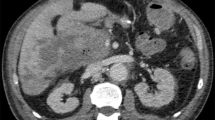Abstract
Permanent bile flow following hepatoportoenterostomy for biliary atresia is presumed to follow mucosal healing of the biliary tract to the intestinal epithelium, but the morphology of the anastomosis and the histology of the neo-biliary duct is not known. Experimental portoenterostomies were constructed in five normal 10-kg mini-pigs at approximately 3 months of age to study the healing of the anastomosis. The extrahepatic bile duct was resected in continuity with an en-bloc 1.5 × 0.3-cm segment of liver at the porta hepatis and biliary drainage was achieved with a Roux-en-Y jejunal limb. The bile duct remnant at the porta hepatis measured 3 mm in diameter. HIDA scan performed at 2 months showed prompt excretion of the radioisotope and normal function of the jejunal limb. Animals were killed at 2 weeks, 1 month, and 3 months following operation and the intact hepatobiliary anastomosis examined by routine histology and histochemical staining for acid and neutral mucins. At 2 weeks the biliary epithelial ducts were hyperplastic and showed evidence of cellular regeneration and cholangitis. By 1 month the biliary and intestinal epithelia were in close approximation. At 3 months the biliary-intestinal epithelium was healed, forming a funnel-like autoanastomosis with normal proximal biliary epithelium and distal intestinal epithelium. An intervening zone of hybrid biliary-intestinal epithelium showed basal crypts with characteristics of biliary epithelium, while the superficial glandular epithelium resembled intestinal villi. Mucin histochemistry of the hybrid epithelial lining revealed predominantly neutral mucins in the basal region of the mucosa characteristic of biliary mucosa. The luminal epithelium revealed a high acid mucin content, including goblet cells. A microvillus brush border, rich in neutral mucin, was also present apically on the luminal most cells. We conclude that: (1) hepatoportoenterostomy in normal mini-pigs is a reproducible model to study healing of the anastomosis; (2) a continuous, intact hepatobiliary-intestinal mucosa is present within 3 months following portoenterostomy; and (3) the neo-epithelium has a hybrid biliary-intestinal appearance. This study may have application to understanding the cause of cholangitis following portoenterostomy for biliary atresia.
Similar content being viewed by others
References
Esterly JR, Spicer SS (1968) Mucin histochemistry of human gallbladder: changes in adenocarcinoma, cystic fibrosis, and cholecystitis. J Natl Cancer Inst 40: 1–10
Gautier M, Jehan P, Odievre M (1976) Histologic study of biliary fibrous remnants in 48 cases of extrahepatic biliary atresia: correction with postoperative bile flow restoration.J Pediatr 89: 704
Getty R (1975) Digestive system of the pig. In: Sisson, Grossman (eds) The anatomy of the domestic animals. Saunders, Philadelphia, pp 1280–1281
Graeve AH, Volpicelli N, Kosloske AM (1982) Endoscopic recanalization of a portoenterostomy, J Pediatr Surg 17: 901–903
Hashimoto T, Yura J (1981) Percutaneous transhepatic cholangiography (PTC) in biliary atresia with special reference to the structure of the bile ducts. J Pediatr Surg 16: 22–25
Hays DM, Kimura K (1981) Biliary atresia — new concepts of management. Curr Probl Surg XVIII, No. 9
Hirsig J, Kara O, Rickham PP (1978) Experimental investigations into the etiology of cholangitis following operation for biliary atresia. J Pediatr Surg 13: 55–57
Kasai M, Suzuki HK, Ohashi E (1978) Technique and results of operative management of biliary atresia. World J Surg 2: 571
Lilly JR (1986) Biliary atresia: the jaundiced infant. In: Welch KJ, Randolph JG, Ravitch MM, O'Neill JA Jr, Rowe MI (eds): Pediatric surgery, 4th edn. Yearbook, Chicago, p 1049
Lilly JR (1988) Fourth Biliary Atresia Registry report: biliary atresia registry. Section on Surgery, Am Acad Pediatr
McFadden DE, Owen DA, Reid PE, Jones EA (1985) The histochemical assessment of sulphated and non-sulphated sialomucin in intestinal epithelium. Histopathology 9: 1129–1137
Author information
Authors and Affiliations
Rights and permissions
About this article
Cite this article
Touloukian, R.J., Barwick, K.W., Vasseur, B.G. et al. Experimental hepatoportoenterostomy: duct mucosal healing with hybrid biliary-intestinal epithelium forming an autoanastomosis. Pediatr Surg Int 5, 255–259 (1990). https://doi.org/10.1007/BF00169665
Accepted:
Issue Date:
DOI: https://doi.org/10.1007/BF00169665




